“In a Woman’s Voice: An Alternative Gamification of The Oregon Trail” – authors in conversation
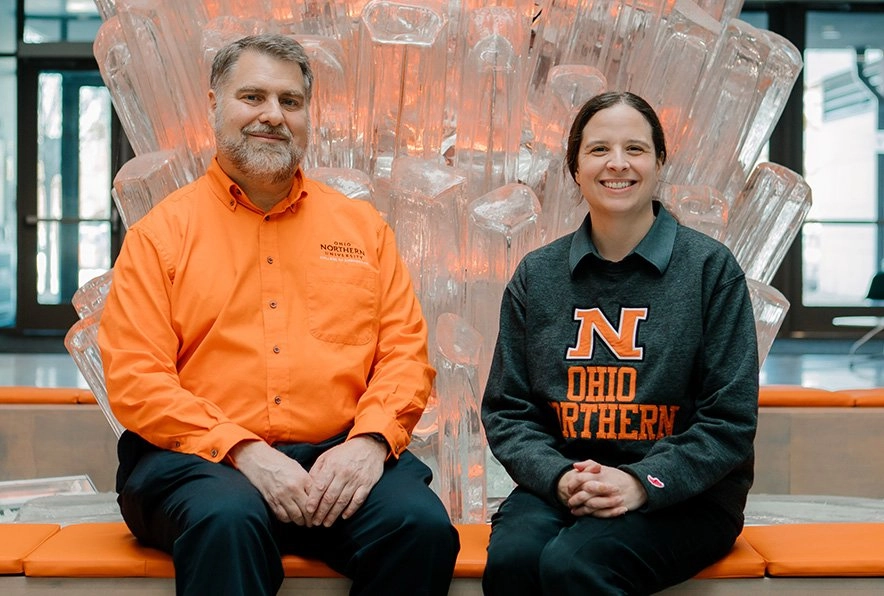
By Dr. Stephany Coffman-Wolph and Dr. John K. Estell
We are two of the authors of the paper, “In a Woman’s Voice: An Alternative Gamification of The Oregon Trail,” which was one of the four Finalists for the 2024 Best Diversity Paper Award. To provide context, our second-semester introductory programming course has had the writing of educational software as a culminating design experience. Over the years, this assignment has morphed from an individual to a client-based team assignment. To help students work with clients, we adopted a “sandbox” approach where team members would first learn how to work with each other by writing a prototype of the classic The Oregon Trail computer game, thereby allowing mistakes to be made in a safe environment. However, program growth progressed to the point that using a client-oriented design assignment became unmanageable.
The following is from a conversation between the authors that has been heavily edited to fit within the specified length limitation.
John: It was Stephany’s idea back in fall 2021 that we replace the design project with a variant of The Oregon Trail game. Stephany, can you talk about how you came up with this?
Stephany: It was just a natural progression, as we started talking about the belonging, inclusion, and diversity efforts happening on campus, and that ABET was moving toward requiring DEI content in the curriculum, so it seemed like a good idea. Plus, I thought Oregon Trail sucked as a game.
J: Can you explain what you did not like about it?
S: We played it a lot in middle school, but I never enjoyed it. I thought it was dumb as you could do it once, and it was somewhat entertaining, but after that, it was really, really boring. It was like, “Yeah, fine, I learned about the Oregon Trail, whatever.” I don’t think that, as a sixth grader, I was aware that there wasn’t a female character. However, at the same time, my teacher was having us read a bunch of books, and she split it such that the girls read one about the Trail from a female character perspective while the boys read one from a male perspective. In retrospect, I think it was her way to make it more interesting for all of her students.
J: When we created the initial version of our Oregon Trail assignment in Spring 2022, one of your major contributions was incorporating the fictional children’s book, “The Oregon Trail Diary of Hattie Campbell,” into the assignment.
S: Yes, although I read it when I was older. I have a collection of books from multiple perspectives involving American Westward Expansion. I also collect books about historical women. I’m the type of person that, when I go to a museum like Colonial Williamsburg, I go to their gift shop and buy books about Martha Washington, not George.
J: How did you feel things went that first year?
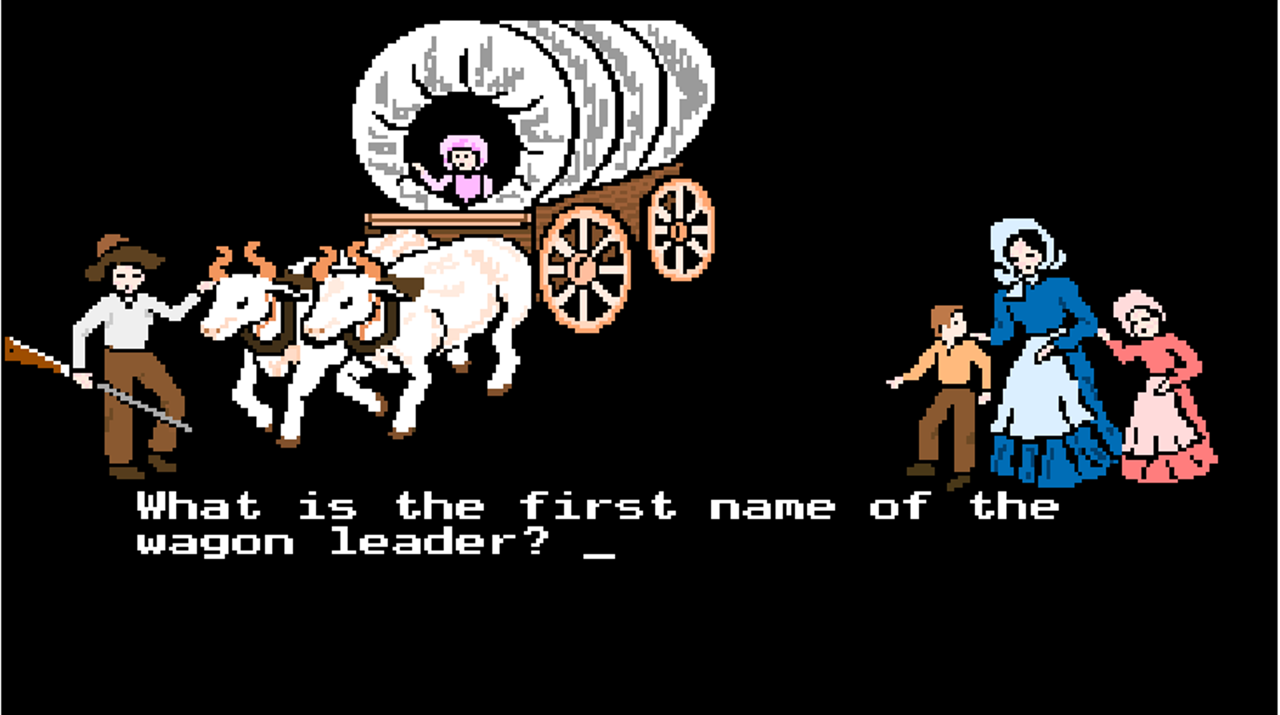
Screen capture of player name request imagery from the 1990 IBM PC version of The Oregon Trail. [“The Oregon Trail,” MECC, [Online]. Available: https://classicreload.com/oregon-trail.html. [Accessed 11 January 2024].
S: Given that we threw the project together to see how this approach would work, I think it went well. We were also emerging from the pandemic, so I think it was a good project for getting students back working together. We had a lot of women in that class along with a pretty diverse group of students overall, which also helped. Our “let’s run with this and see where it goes” approach resulted in having few restrictions and directions in place, which gave our students opportunities. I think the creativity we saw reached levels we were not expecting. For example, some of our musically talented students researched the music of the time and added it to their application because they were passionate about it. Several teams included some cool pixel artwork. One team asked if the people of that era knew about dinosaurs, and I mentioned that they were finding their bones while they didn’t know about dinosaurs. So they researched and added that element to their game.
J: What changed in Spring 2023?
S: While we did most of the same stuff in the introductory programming course, we had more resources available, which helped with historical accuracy. Additionally, several of the students were also taking your Interactive Fiction course where you were doing a deep dive into representation issues, and they brought that knowledge back into their applications.
J: Yes, we had the time to focus on various gender-related issues, such as how women back then were not given a choice by their husbands regarding emigration. And while it’s easy to show computer games featuring tropes blatantly objectifying women, I think that taking a supposedly benign game like Oregon Trail and showing how it subtly portrays a white male-centric bias had an outsized impact on our students, which was then reinforced by challenging them to remake the game from a female perspective.
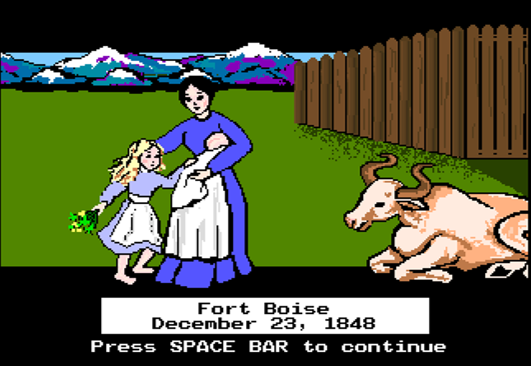
Screen capture of Fort Boise imagery from the 1990 IBM PC version of The Oregon Trail. [“The Oregon Trail,” MECC, [Online]. Available: https://classicreload.com/oregon-trail.html. [Accessed 11 January 2024].
S: This reminds me of an image near the end of the game where there’s the woman in front of Fort Boise holding a baby with her young daughter at her side. And they’ve been on the trail for how long? At what point did they stop to have the baby? I doubt she gave birth in the back of the wagon while it was moving. They don’t talk about her experience at all.
J: The game presents the story of the heroic white male figure with his rifle in one hand and guiding the oxen’s yoke in the other, leading his family westward, but nothing is said about his wife. We used Lillian Schlissel’s “Women’s Diaries of the Westward Journey” as one of our required books in the Interactive Fiction course. From her research, she estimates that at least one in five women were in some stage of pregnancy during their journey. A woman’s family had to stop for her to give birth while the rest of the wagons headed onward, making for a harrowing experience: a family alone, no doctor present, probably no midwife, and no resources available other than what’s in their wagon. So I agree: what was her experience emigrating while carrying her child, first in the womb and then in her arms? Why wasn’t her story told?
S: We see that male-centric bias happening throughout software design. Many of our AI systems can’t see people who aren’t pasty pale white. You notice this in health apps that lack any features for tracking female-specific health metrics. Did that company not have a diverse group of testers? I think, as an industry, we do a really bad job of looking at representation. We need to teach that early so that we don’t keep causing the same data problems over and over again.
J: So what impact does our approach to re-envisioning The Oregon Trail game have?
S: I don’t know; that’s really hard to measure. Am I having any impact when I do community outreach or when advising capstone? It’s the same problem. I think what we’re hoping is that, by seeing and understanding that representation is an issue, they’ll be more inclusive down the road when handling problems that have similar issues. Writing The Oregon Trail “in a woman’s voice” provides an exercise in examining a differing perspective, a skill that they can hopefully replicate when considering how others might be impacted by a design. Now our paper focused primarily on the Interactive Fiction course you taught with Lisa Robeson from the English Department. Were you able to take anything from that experience and feed it back into our introductory programming assignment?
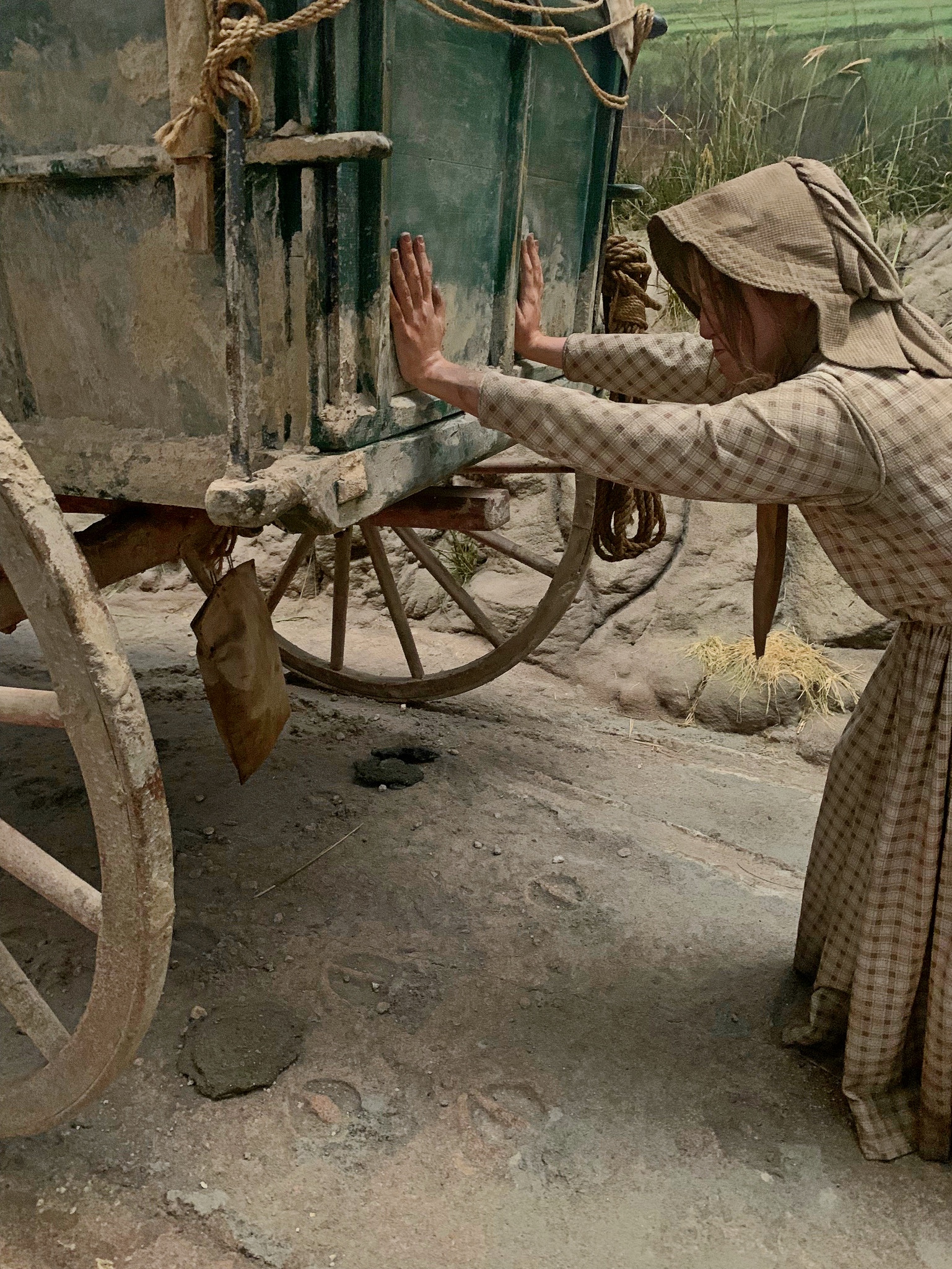
Portion of diorama of a family on the Oregon Trail approaching Chimney Rock, The Archway (Kearney, NE). Photo taken by Stephany Coffman-Wolph, 13 October 2021.
J: Yes. For spring 2024, I was able to use condensed versions of the lectures regarding female tropes and representation to bring these issues to the forefront. We also now have a greater amount of reference materials available, especially the diaries and letters collected in the 11-volume “Covered Wagon Women” series. This allowed each team to create a female protagonist persona for their game based on the diary of a woman who experienced first-hand the rigors of the Trail. By selecting the four volumes available for checkout through the Internet Archive, each team had a different game, because of the different personas and, to a lesser extent, some differentiations because of the year that diarist emigrated.
S: And what about the upcoming spring semester?
J: While there’s a lot of reference material about the white female experience, there’s much less available for other marginalized groups that experienced the Trail – both those who emigrated, and those who already lived there. In particular, the Native American’s oral tradition of passing their history down to the next generation means that few written records are available. I was fortunate that, while attending the 2023 Oregon-California Trails Association Convention in western Nebraska, a historian led me to the book “With My Own Eyes,” a transcription of stories told by a Lakota woman that includes multiple accounts of the 1855 Blue Water Massacre that occurred in a Lakota village only a few miles away from one of the better-known stops on the Oregon Trail, Ash Hollow. I had been planning on asking next year’s class to incorporate the Lakota perspective as we focus on the various perils in place along the Platte River, and then I received the November 2024 issue of Smithsonian Magazine. In it is the article “The Living Memory of Blue Water” mentioning the massacre, plundered artifacts, and the path currently being forged toward reconciliation. I think it’s fortuitous that this article came out when it did, as it will succinctly provide needed context for my students.
S: I read some of those articles about members of Indigenous groups playing Oregon Trail; I’m sure that it must be a frustrating experience to be misrepresented in some situations and invisible in others. Some of these vintage games provide a way to discuss representation issues, much like we use sci-fi to talk about social issues. It doesn’t have to be Oregon Trail: take any piece of history, and in making it a game, have the students sit down and consider the perspectives of those involved. We need more assignments like that because, like Oregon Trail, by focusing on white male protagonists, you’re excluding a ton of people.
About the Authors
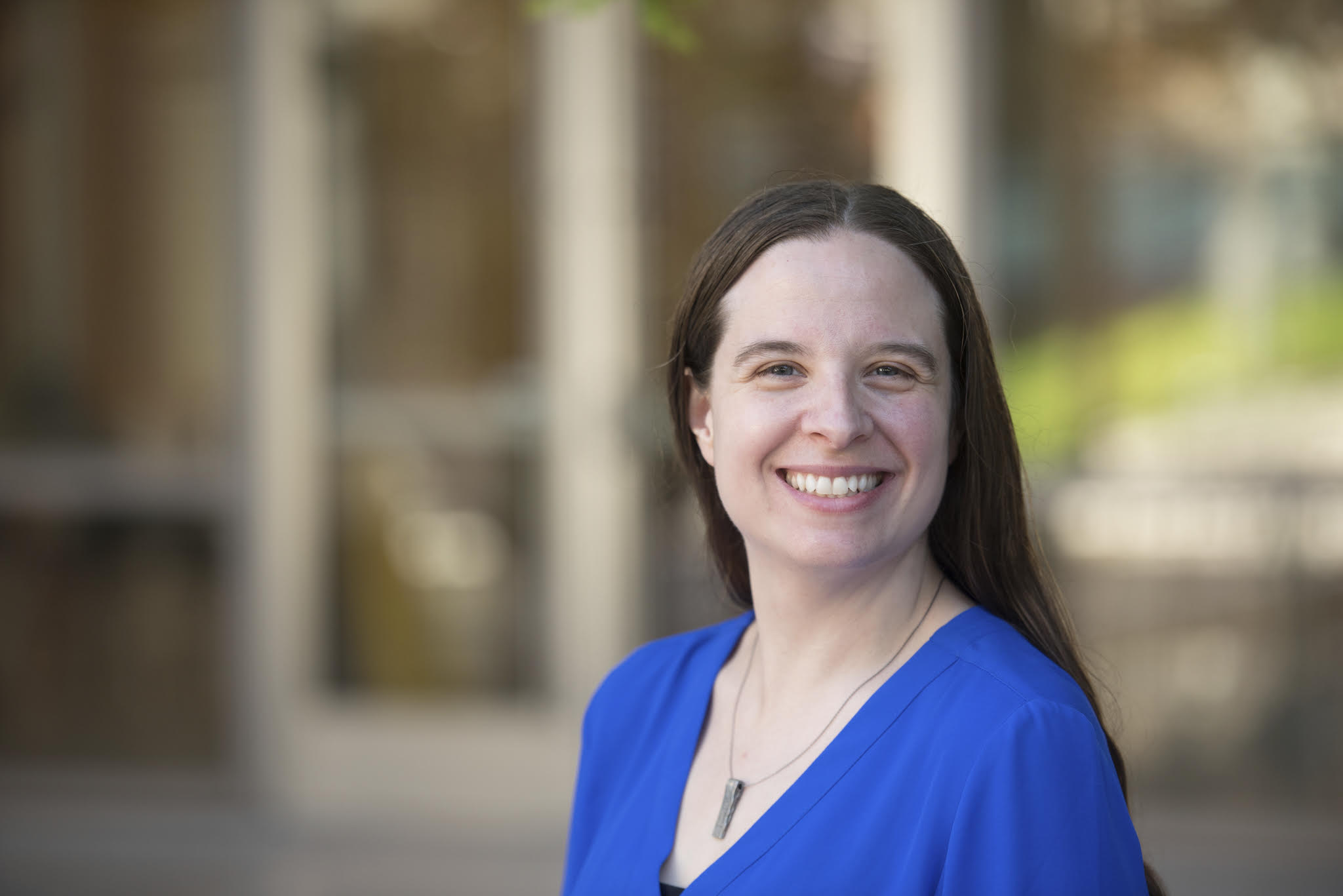 Dr. Stephany Coffman-Wolph received her PhD from Western Michigan University and is currently an Assistant Professor in the ECCS Department (in Computer Science) at Ohio Northern University. Previously, she worked at The University of Texas at Austin and West Virginia University Institute of Technology (WVU Tech). While at WVU Tech she was a founding member and faculty advisor of AWESOME (Association of Women Engineers, Scientists, Or Mathematicians Empowerment) at WVU Tech. She is actively involved in community outreach with a goal of increasing the number of women in STEM and creating effective methods for introducing young children to CS concepts and topics. Dr. Coffman-Wolph’s research interests include: Artificial Intelligence, Fuzzy Logic, Software Engineering, STEM Education, and Diversity and Inclusion within STEM. While growing up in Michigan, she was a dancer (ballet, tap, and jazz) until she graduated high school and a competitive figure skating through her senior year of college. Her hobbies include: reading mystery and fantasy books, knitting, shopping (especially to add to her shoe collection), yoga, and disc golf.
Dr. Stephany Coffman-Wolph received her PhD from Western Michigan University and is currently an Assistant Professor in the ECCS Department (in Computer Science) at Ohio Northern University. Previously, she worked at The University of Texas at Austin and West Virginia University Institute of Technology (WVU Tech). While at WVU Tech she was a founding member and faculty advisor of AWESOME (Association of Women Engineers, Scientists, Or Mathematicians Empowerment) at WVU Tech. She is actively involved in community outreach with a goal of increasing the number of women in STEM and creating effective methods for introducing young children to CS concepts and topics. Dr. Coffman-Wolph’s research interests include: Artificial Intelligence, Fuzzy Logic, Software Engineering, STEM Education, and Diversity and Inclusion within STEM. While growing up in Michigan, she was a dancer (ballet, tap, and jazz) until she graduated high school and a competitive figure skating through her senior year of college. Her hobbies include: reading mystery and fantasy books, knitting, shopping (especially to add to her shoe collection), yoga, and disc golf.
ASEE Divisions: FYP, CoED, PCEE, and WIED
Pronouns: she/her/hers
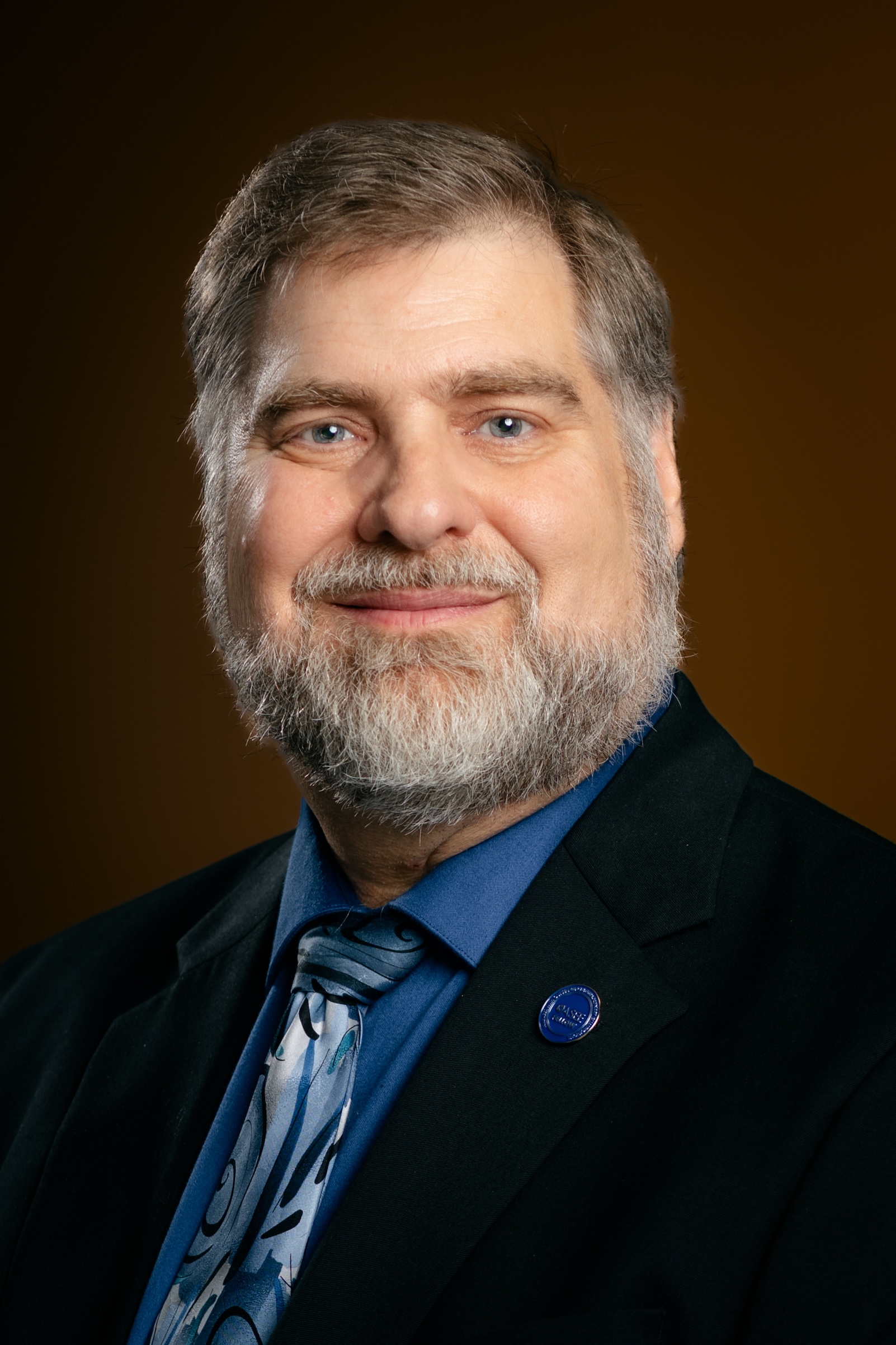 Dr. John K. Estell is the Reichelderfer Endowed Chair and Professor of Computer Engineering & Computer Science at Ohio Northern University, where he teaches first-year programming, UI/UX design, and capstone preparation courses. He believes that effective learning occurs when students are provided with active, hands-on experiences that tie real-world practice with theory. John’s current research involves identifying observable behaviors associated with entrepreneurial mindset, developing psychological safety within teams, modeling sources of engineering design constraints, and using educational software development as a lens for exploring representation issues. Service to others plays a significant role in his life; currently, John chairs ASEE’s IT and Awards Policy Committees; he previously served on the ASEE Board of Directors from 2020-2023 and was CDEI Program Chair for the 2019 Annual Conference. John is a Fellow of both ASEE and ABET. He received his PhD from the University of Illinois at Urbana-Champaign.
Dr. John K. Estell is the Reichelderfer Endowed Chair and Professor of Computer Engineering & Computer Science at Ohio Northern University, where he teaches first-year programming, UI/UX design, and capstone preparation courses. He believes that effective learning occurs when students are provided with active, hands-on experiences that tie real-world practice with theory. John’s current research involves identifying observable behaviors associated with entrepreneurial mindset, developing psychological safety within teams, modeling sources of engineering design constraints, and using educational software development as a lens for exploring representation issues. Service to others plays a significant role in his life; currently, John chairs ASEE’s IT and Awards Policy Committees; he previously served on the ASEE Board of Directors from 2020-2023 and was CDEI Program Chair for the 2019 Annual Conference. John is a Fellow of both ASEE and ABET. He received his PhD from the University of Illinois at Urbana-Champaign.
ASEE Divisions: CoED, DEED, ECE, ENT, ERM, FYP, and MULTI
Pronouns: he/him/his
Do you want to become a guest blogger?
CDEI Guest Blog highlight future events, describe best practices, or share calls to action by CDEI members. We invite you to propose posts that share brief research highlights, reports of impactful initiatives, critical thought pieces, and resources you find useful. We especially encourage emerging scholars to share their work. If you are interested in sharing a blog or resource post, you may submit your proposal here. All posts are screened and edited.

